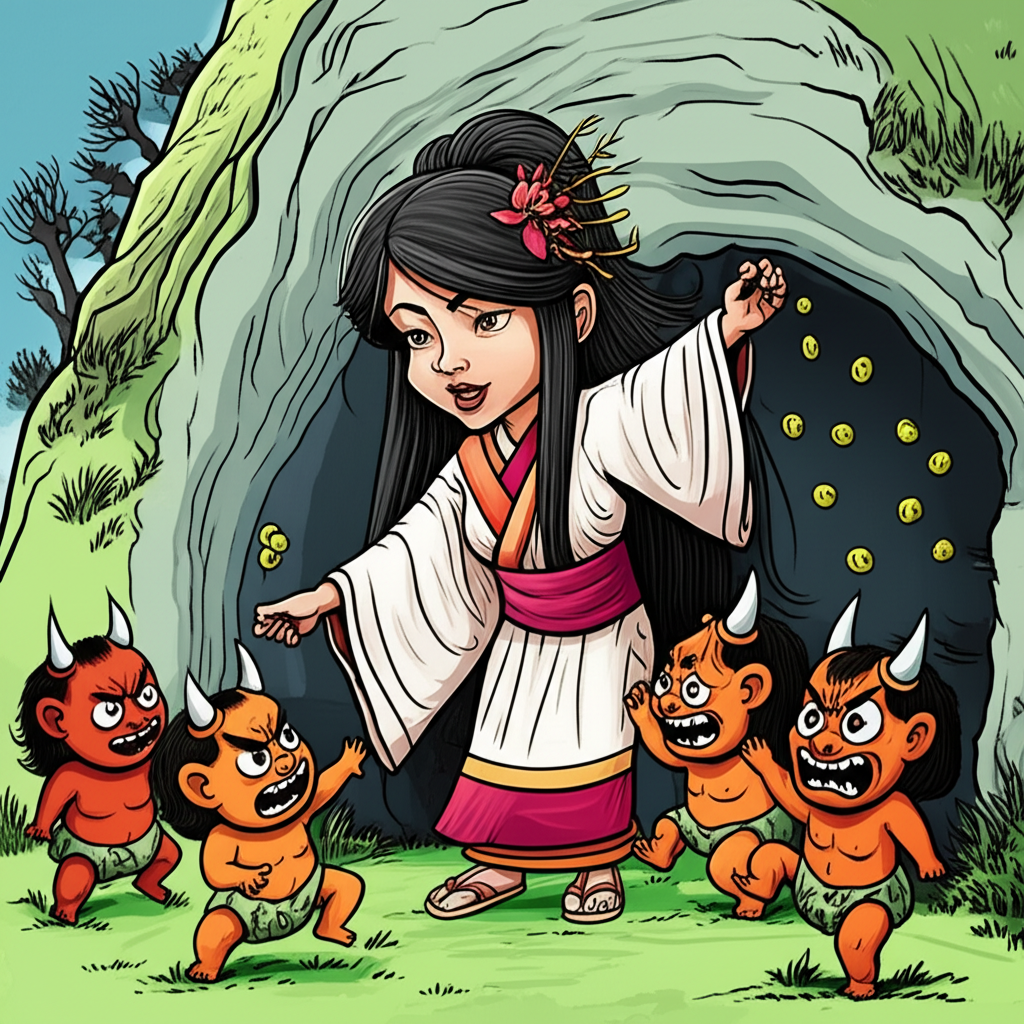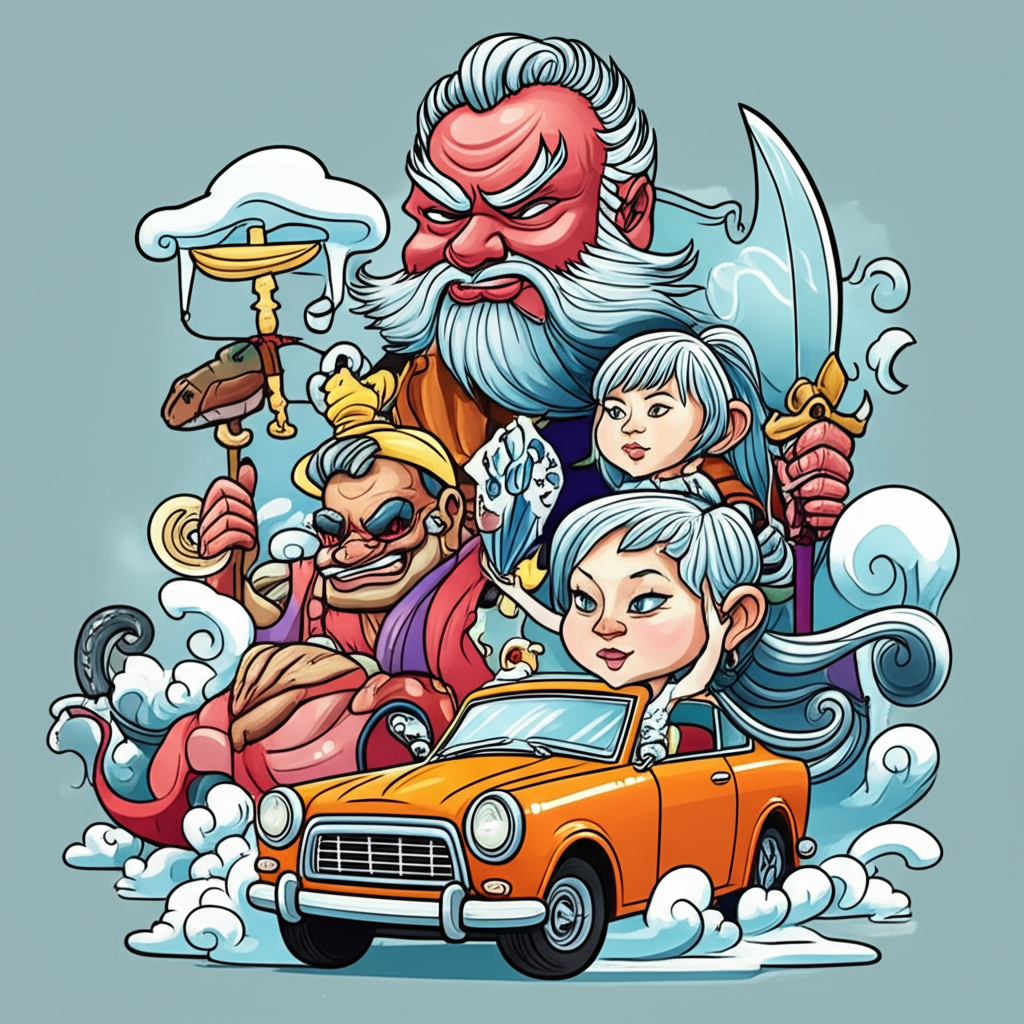
Every culture weaves stories to explain the world, to impart lessons, and to celebrate the rhythms of life. The tale of Amaterasu and the Oath of Setsubun, while not a recognized canonical myth, draws inspiration from the rich tapestry of ancient Japanese folklore. It is a traditional story, much like many others passed down through generations by ancient peoples, reflecting their understanding of nature, their fears, and their hopes. This narrative is presented solely for cultural, historical, and educational understanding, recognizing it as a product of human imagination and a window into a bygone worldview.
Origins and Cultural Background
This particular narrative finds its roots in the cultural landscape of ancient Japan, a society deeply intertwined with the natural world. Imagine a time when life was dictated by the sun’s journey across the sky and the relentless cycle of the seasons. People lived in close harmony with the land, their livelihoods tied to agriculture, their existence a constant interplay with the elements. The world was perceived as alive, imbued with unseen forces and spirits known as kami. These kami inhabited mountains, rivers, trees, and even the very air, influencing every aspect of human life.
In this era, the transition between seasons was not merely a shift in temperature but a profound spiritual event. Winter’s grip, with its barren landscapes and scarcity, represented a time of dormancy and potential peril. The arrival of spring, heralded by the gradual return of warmth and life, was a cause for immense relief and celebration. It was a time when the boundaries between the visible and invisible worlds were believed to thin, allowing both benevolent and malevolent spirits to exert their influence. Rituals of purification and renewal were therefore paramount, designed to banish lingering negativity and invite prosperity for the coming year. This ancient worldview, steeped in animism and a profound respect for nature’s power, formed the fertile ground from which tales like the Oath of Setsubun could emerge, providing comfort and explanation in an often unpredictable world.
Character Description: Amaterasu Omikami
Central to this particular narrative, as with much of Japanese mythology, is Amaterasu Omikami. In these ancient traditions, Amaterasu is depicted as the paramount celestial figure, often revered as the goddess of the sun. It is crucial to understand that in this context, she is a symbolic entity, a personification of the sun’s life-giving power, rather than a deity to be worshipped.
Symbolically, Amaterasu embodies light, warmth, and purity. She is described as the source of all illumination, bringing forth dawn and nurturing life on Earth. Her presence ensures the rhythm of day and night, the growth of crops, and the general flourishing of the world. In the stories, she is often portrayed with a serene countenance, radiating a gentle yet powerful energy. Her symbolic attributes extend beyond mere sunlight; she represents order, harmony, and the enduring promise of renewal. When she shines, the world thrives; when her light is obscured, chaos and despair threaten. Her character, therefore, serves as a powerful metaphor for the vital forces that sustain existence, a narrative construct designed to explain the sun’s undeniable importance to ancient agrarian societies.
The Main Story: Amaterasu and the Oath of Setsubun
In the celestial realm, where the sun held court, Amaterasu Omikami cast her benevolent gaze upon the terrestrial world. For countless ages, her radiant light had nurtured the Earth, coaxing life from the soil, warming the rivers, and guiding the seasons in their graceful dance. Yet, as the deep winter months began to wane, a subtle shift disturbed the delicate balance. The world, though yearning for spring’s embrace, felt a lingering chill, a persistent whisper of winter’s reluctance to fully depart.
Below, the people, hardy and resilient, sensed it too. The days were lengthening, but the true warmth seemed hesitant, held captive by an unseen force. They performed their rituals, burning sacred fires and offering prayers for the return of bountiful spring, but a faint, persistent shadow seemed to cling to the edges of the world, a chill not of ice, but of a lingering stagnation. This was the time of Setsubun, the traditional demarcation between winter and spring, a moment fraught with both anticipation and apprehension. It was believed that at this threshold, the boundary between the human world and the realm of the unseen grew thin, allowing mischievous spirits, the Oni of winter’s prolonged gloom, to wander.
Amaterasu, from her luminous abode, perceived this subtle imbalance. She saw the hopes of the people, their longing for the vibrant greens and fertile bounty of spring. She also sensed the persistent, almost reluctant, grip of winter’s essence—not malicious, perhaps, but a heavy inertia that threatened to delay the world’s awakening. This was not a darkness born of malice, but a lingering chill, a reluctance for the old to give way completely to the new.
With a gentle resolve, Amaterasu decided to act. She would not merely shine, she would decree. She would make an oath, a celestial promise to ensure the unfailing cycle of life. Descending slightly from her highest abode, not in a blaze of overwhelming light, but in a soft, permeating warmth that touched every corner of the Earth, she spoke. Her voice, a resonant hum that vibrated through the very fabric of existence, was heard not with ears, but with the heart of every living thing.
"Hearken, O world," she declared, her light bathing the landscape in a golden hue. "I, Amaterasu, giver of light and life, make this solemn promise upon the threshold of Setsubun. As the lingering shadows of winter attempt to cling, I swear that my light shall prevail. I shall push forth the warmth, banish the chill of stagnation, and ensure the vibrant return of spring. Let no persistent gloom hold dominion over the budding life. Let the cold spirits of delay be scattered by the very essence of my light, making way for growth and renewal. This is my Oath of Setsubun: to perpetually reaffirm the triumph of warmth over cold, of life over dormancy, and of hope over lingering despair. And as a sign, let the humble bean, symbol of vitality and new beginnings, be cast forth by the people, echoing my decree, scattering the lingering whispers of winter and inviting the bounty of the coming year."
As her words resonated, a wave of palpable warmth swept across the land. The last vestiges of winter’s stubbornness seemed to dissipate like mist before the morning sun. The air lightened, and a fresh, invigorating energy infused the atmosphere. Below, the people, though they may not have heard her words directly, felt the profound shift. Inspired by this renewed vigor, they began to mimic her celestial decree. On the day of Setsubun, they would gather, throwing roasted soybeans (mamemaki) while chanting "Oni wa soto! Fuku wa uchi!"—"Demons out! Fortune in!"—a ritualistic echoing of Amaterasu’s grand oath to scatter the lingering chill and welcome the blessings of spring. It was their way of participating in the great cosmic renewal, a physical manifestation of Amaterasu’s enduring promise.
Symbolism and Meaning
To the ancient people who might have shared such a narrative, the story of Amaterasu and the Oath of Setsubun would have been rich with symbolism. It represented, first and foremost, the perennial triumph of light over darkness, not just literally, but also metaphorically. The "lingering chill" or "Oni of winter’s gloom" could symbolize any form of adversity: illness, bad luck, scarcity, or even internal fears. Amaterasu’s oath, therefore, offered reassurance that no matter how harsh or prolonged the winter, spring’s warmth and life would inevitably return.
It also underscored the profound importance of seasonal cycles and the belief that these cycles were maintained by powerful, benevolent forces. The story could have instilled a sense of security and trust in the natural order. Furthermore, the inclusion of the human ritual of Setsubun, inspired by Amaterasu’s act, would have emphasized the interconnectedness between the divine and the human realms. It suggested that human actions, even simple ritualistic ones, played a role in maintaining harmony and welcoming good fortune, echoing the greater cosmic will. The story served as a moral guide, encouraging active participation in purification and renewal, and fostering a hopeful outlook on life’s inevitable challenges and transitions.
Modern Perspective
Today, while the specific tale of Amaterasu’s Oath of Setsubun may not be widely recognized in its exact form, the broader themes it encapsulates resonate deeply within modern cultural interpretations of Japanese mythology. Amaterasu herself remains a prominent figure in literature, art, and popular culture. She appears in numerous anime, manga, and video games (such as the critically acclaimed "Ōkami," where the player embodies a wolf form of Amaterasu), often depicted as a powerful yet benevolent force, a guardian of light and nature. These contemporary portrayals draw upon her symbolic attributes of light, purity, and the vanquishing of darkness, reinterpreting them for new audiences and narratives.
The Setsubun festival itself continues to be observed across Japan, though for many, it has evolved into a cultural tradition rather than a purely religious practice. Families still gather to throw beans, shouting "Oni wa soto! Fuku wa uchi!", a charming and lively way to welcome spring and ensure good luck. Cultural studies scholars analyze such myths to understand ancient worldviews, societal values, and the evolution of storytelling. The narrative elements—the struggle between opposing forces, the promise of renewal, and the connection between the natural and human worlds—continue to be powerful themes that transcend time, providing a rich source of inspiration and insight into the human condition.
Conclusion
The narrative of Amaterasu and the Oath of Setsubun stands as a testament to the enduring power of human imagination and the cultural heritage it creates. It is a traditional story, a legend crafted by ancient peoples to make sense of their world, to articulate their hopes for renewal, and to imbue the natural cycles with deeper meaning. It is essential to reiterate that this, like all myths, is a cultural story, not a belief system to be adopted or practiced.
As Muslims, we firmly recognize that only Allah (SWT) is the true Creator and Sustainer of the heavens and the Earth, the One without peer or partner, the source of all light and life. Our faith teaches us that He alone is worthy of worship, and all power, mercy, and guidance emanate solely from Him.
Yet, understanding such cultural narratives allows us to appreciate the diverse ways humanity has sought to comprehend its existence. These stories, whether they speak of sun goddesses or celestial oaths, serve as valuable windows into the past, enriching our understanding of human history, creativity, and the universal impulse to tell tales that explain, inspire, and connect us to the world around us. They remind us of the rich tapestry of human experience and the profound role storytelling plays in preserving cultural identity and fostering a deeper appreciation for the imaginative spirit that resides within us all.





